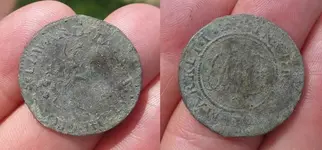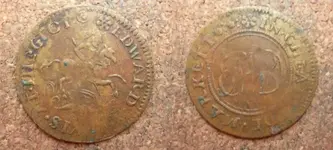Bill D. (VA)
Silver Member
- Joined
- Oct 7, 2008
- Messages
- 4,711
- Reaction score
- 6,212
- Golden Thread
- 6
- Location
- SE Virginia
- 🥇 Banner finds
- 6
- 🏆 Honorable Mentions:
- 2
- Detector(s) used
- F75 SE (land); CZ-21 (saltwater)
- Primary Interest:
- Other
A while back I found this 27mm brass penny token issued by Edward Jarvis around 1670 in an early trash pit here in southeast Va. Jarvis was the landlord of The George Tavern located in Cheapside, a section of London. On the obverse is depicted St. George on horseback slaying the dragon with the legend "EDWARD IARVIS AT THE GEORGE". On the reverse is an elaborate monogram in the center, with the legend "IN CHEAPSIDE MARKETT" on the periphery. Below are pics of the actual recovered token along with a more detailed pic of a better grade example. Mine has a nice gray patina, but so far I've only used dry cleaning methods. However, it looks like this token could be cleaned a bit more to improve its appearance and details, but I'm a little hesitant as I certainly don't want to damage it. It was suggested previously that a warm peroxide bath might do the trick, but I haven't had much success with that method on coppers. I also have some blue ribbon coin cleaner which is by far the best product I've ever used on old coppers, but not sure how it would do on brass. Anyway, I'm totally open to suggestions at this point, and hopefully I can find a way that I feel confident about, or I'll just leave as is. Thanks for any input.
Attachments
Upvote
3



